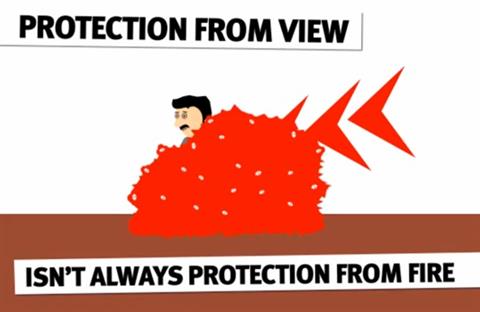
The Samir Kassir Eyes (SKeyes) Center for
Media and Cultural Freedom released its Journalist Survival Guide, a video
training curriculum for journalists, activists and media professionals working
in areas of conflict and other dangerous zones. The guide, which includes 14
animated videos in Arabic and English as well as downloadable scripts in both
languages, was designed to serve individuals operating in war zones.
The lessons in the guide are not only aimed
at journalists on the ground, but also media specialists, photographers, video
editors, activists and others who find themselves in dangerous conflict zones.
Lesson one instructs reporters on how to take
cover if caught in the middle of a crossfire, such as taking refuge behind
large rocks, buildings or trees, and waiting at least 10 to 20 minutes before
coming out. Another lesson outlines methods for protecting sources’ safety,
such as how to establish first contact and how to edit video footage. One
lesson also shows how to protect oneself from tear gas and what to do once
exposed. Many of the other videos center on protecting one’s computer from
malware and hacking, ensuring a safe connection, storing sensitive data and
maintaining mobile security and social media safety, all of which are deemed
necessary for journalists operating in today’s digital world.
Additionally, the guide provides a two-part
lesson in basic first-aid practices that could be put to use when delivering
assistance to an injured person before professional medical personnel arrive.
It also lays out the rules of international humanitarian laws that apply to
persons not involved or no longer involved in fighting, including children, the
elderly, sick and wounded soldiers, and prisoners of war.
The idea for the project was conceived last
year, and the center began designing it in March 2012, said Ayman Mhanna,
executive director of SKeyes.
In the initial phases, SKeyes consulted
citizen journalists in countries such as Syria and Egypt to find out what the
most important issues were in terms of risk and security, and to identify the
questions that needed to be raised.
“We
wanted to develop a curriculum using low-resolution videos which are easy to
download,” Mhanna added. “We partnered up with expert organizations who worked
pro bono because they believed in our cause.”
While SKeyes drafted the project, other
organizations such as the Lebanese Red Cross – which provided the information
for lessons on maintaining personal safety and the safety of others – delivered
material in the videos. The Global Center for Journalism and Democracy supplied
material needed for the accurate reporting module, while the National
Democratic Institute did the same for the computer and online safety lessons.
Lebanese production house Kook Creative Studio worked on the animation.
According to Mhanna, the guide has been
distributed to almost 5,000 recipients, all on SKeyes’ mailing list, including
partner organizations who posted a link to the publication on their websites,
ready for downloading and sharing.